Silage management – the path to optimal grass silage
Forage is the most important component in the feeding of dairy cattle. Combined with high proportionate costs in full-cost accounting in the area of dairy cattle, it is very important to ensure that high-quality forage is harvested. Feed costs account for the largest portion of milk production costs. Forage represents the biggest part of a dairy ration, therefore it offers the highest potential for cost optimisation.
The economic efficiency of milk production is largely determined by a high forage milk yield. Perfect silage with the best feed value will pay off! What is there to consider for the first and second cut? Here are a few helpful tips and tricks!
Contents
- Step by Step
- Redress gaps in the crop
- Choose the right time to cut the grassland
- Selected cultivation methods for the production of high-quality grass silage?
- Which factors need to be considered during harvesting and ensiling?
- What are the characteristics of a high-quality silage?
- How can silage inoculants help?
- Which silage inoculants are suitable for optimal use?
Step by Step
Every good grass silage begins in the spring with grassland maintenance. The goal here is to achieve or maintain a good sward. This is because only an optimal sward will avoid getting sand and dirt into the silo. Harmful bacteria are found mostly in soil and reach the silo with it, which can have considerable negative effects on the fermentation process and finally the feed quality. Thus, proper grassland maintenance is crucial. The first step is harrowing or grooming. Levelling of molehills
- Ventilation of grassland sward
- Stimulation of tillering
- Reduction of low-quality grasses
- Disposal of manure residues
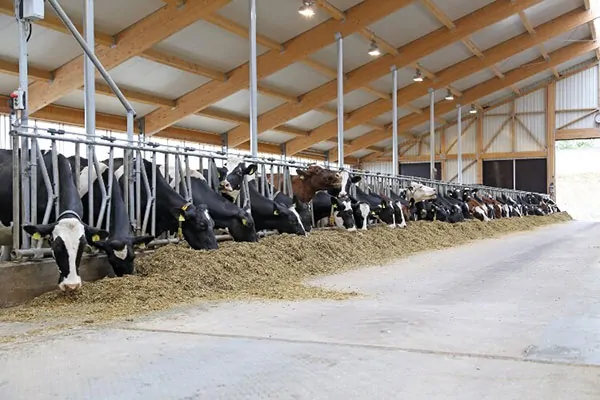
Rolling is recommended as a second step. The advantages are:
- Solidification of frozen soil
- Elimination of trampling damage
- Elimination of machinery track damage
Redress gaps in the crop
If there are holes in the sward, they must be reseeded immediately. Otherwise unwanted, low-quality grass or even weed varieties could spread to these areas. Furthermore, harvesters very easily scrape up sand and dirt at these areas which will enter the feed stock.
Prophylactic measures such as overseeding can fill these gaps. In practice, overseeding (usually around 5 kg/ha) is often carried out with special equipment every spring. For more severe damage, repair seeding is required. This differs from overseeding only by the application rate, often with 15 kg/ha. Due to growth competition from the “old grass”, it is always recommended to carry out reseeding in the autumn. If, for whatever reason, reseeding takes place in the spring, you should start this process very early if the fields are accessible.
Discover how colleagues are handling the situation in 2018/2019:
Choose the right time to cut the grassland
Of course, choosing the right time to cut the grassland is also important. A rule of thumb is the so-called “beer bottle height”. Once the crop has reached this height, the weather must of course also play its part. To get enough sugar in the plant, sun is essential. It is also important to cut the grass before ears/panicles emerge. Grass varieties that have a higher tolerance limit with regard to the timing of this shoots, which means that these varieties come into ear shoots later and thus a longer period of bad weather is no cause for concern.
Selected cultivation methods for the production of high-quality grass silage?
The foundation for a high-quality silage is laid during work on the grassland. Meadows rich in ryegrass are characterised by a high usage intensity and a high sugar content. With proper grassland maintenance, the crop remains dense and strong:
- Fertilisation
- Harrowing
- Reseeding (if required)
- Rolling
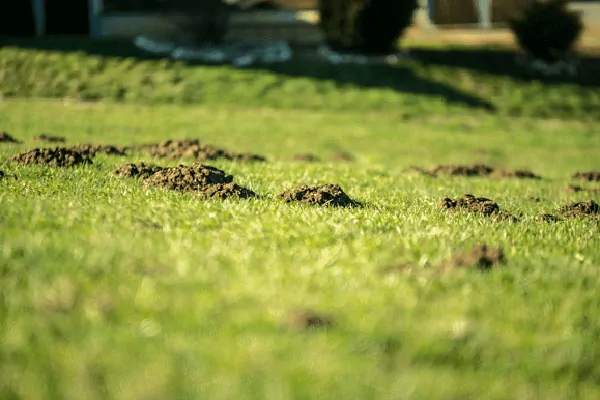
Which factors need to be considered during harvesting and ensiling?
Use the right technology
Basically, there is no “right technology”. There are only the right machine settings. It is important that the harvesters do not work too aggressively. The correct cutting height must be observed, ideally 3 inches. When tedding and raking the grass, the machines should not rake through the soil. Contamination of the harvested crop, as already mentioned, impairs the ensiling process.
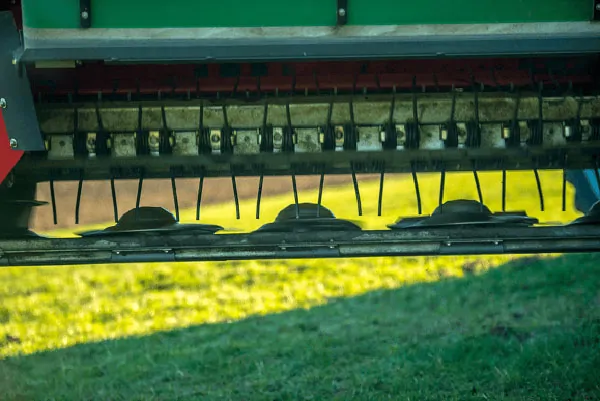
The roller tractor sets the pace
Thanks to a huge advancement in harvesters, very high crop yields per acre are now possible. Unfortunately, the high harvest yield often means that the feed stock is filled too quickly and thus oxygen is enclosed, which has a disadvantageous effect on the ensiling process. The following points should therefore be considered as “compacting rules”:
- The roller tractor sets the filling pace
- Layers should be a maximum of 11 inches
- Fill from the bottom to the top (no unloading and pushing together)
- Falling from the edge to the middle
- High rolling weight on a small supporting surface
- The silo width must be a minimum of double the width of a tractor
- Repeated crossing
- Observe the tyre pressure of the roller tractor (road pressure = silo pressure)
- The rolling weight should represent 1/3 – 1/4 of the hourly harvest yield
If you invest a little more time and diligence here, you will have less trouble and losses when filling the silo!
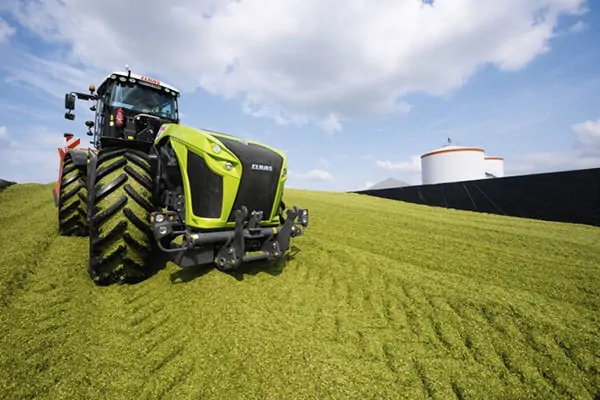
Cover properly
It must be ensured that the silo is covered contemporary after the silo has been filled. Only then can a low-oxygen environment be created as quickly as possible for the fermentation process. If you wait too long, there is a high probability that a higher level of damaging bacteria, yeast and mould will form in the silo due to the delay and the losses can be severe.
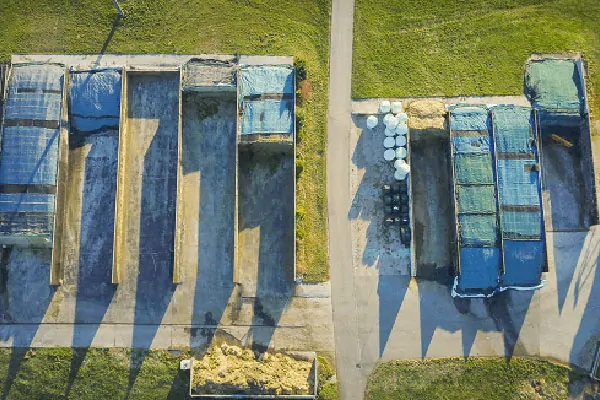
When covering, please consider the following:
- Standard sheets between 120 – 200 µm
- Multi-silo sheets with 500 µm
- Use underlay sheets (suction foil lies close to the silage, less supply of oxygen when covering and removing)
- Use lining wrap for movable silo to protect the actual sheets
- Use silo net
Enough feed protects against reheating
A sufficient feed out rate (usage of silage per week in feet) is decisive for the reduction of reheating. The following points should be taken as a guideline:
- Adjust the silo length, height and width to the number of animals
- Narrow cutting surface (!but double the tractor width!)
- Do not cover too much in advance
- Faster feed out rate (5 feet / week in the winter; >6 feet in the summer)
- Dietary composition
- If applicable, feed cows and cattle from one silo
Furthermore, biological silage inoculants can improve the quality of the silage and counteract reheating.
Don’t forget!
- cut early
- select a suitable silage inoculant
- retract the silage evenly into the silo!
If weather conditions are settled and accessibility to the field is good, cutting and harvesting should be carried out as early as possible. In this case, you should aim for same-day silage. The grassland crop has enormous growth potential, especially for the first cut. A prolonged period of rain can lead to overripe crops. The result is a too high crude fibre contents, at the expense of protein and energy content.
What are the characteristics of a high-quality silage?
| Optimal silage process | (rapid reduction of the pH -> dry matter dependent 4-5) |
| Dry matter: | 35% |
| Crude protein: | 16-18% |
| Crude ash: | <10% |
| Crude fibre: | 220-260g |
| NEL: | >6,3MJ |
| NH3-N: | 8% |
| As much lactic acid as possible | |
| Butyric acid: | <0.3% |
| Acetic acid: | <3% |
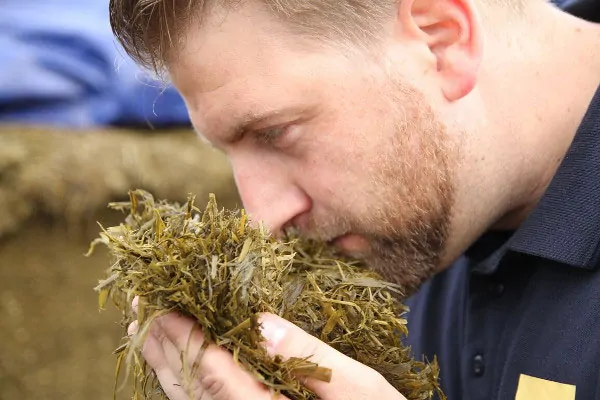
How can silage inoculants help?
Only by creating optimal silage can you be sure that you will be able to feed your animals high-quality silage. The quality of silages depends on the degree of ripeness of the silage, the weather as well as the dry matter and sugar content. In addition, the buffering capacity, nitrate content and number of bacteria are important influencing factors. Some of these factors are within your control as a farmer. You can influence the quality of the silage yourself with the right silage management (choosing the right time to cut the grassland, cutting height, wilting period and time the crop spends in the field, compaction and covering). Other value-determining parameters – such as the fermentation process and the ingredients of the silage, but also the aerobic stability – can be controlled mainly by the use of silage inoculants.
Which silage inoculants are suitable for optimal use?
For standard grass or alfalfa silage, the best would be to use biological silage inoculants with a high proportion of homofermentative bacteria, which produce high quantities of lactic acid and thus ensure a quick and reliable drop in pH in order to hinder fermentation pests as well as a loss in nutrients.
Forages containing more energy and with a tendency to reheating, the biological silage inoculants should contain a special combination of lactic acid bacteria that ensure a good acidification and high aerobic stability. with SYMBIOSIS-EFFECT. Result: The silage remains cool and fresh.
Conclusion
Good silage management is a prerequisite for perfect silage of the highest quality. It begins with grassland maintenance and clean recovery of the silage, accompanied by the use of a suitable silage inoculants and proper, airtight storage, rounded off with the correct removal technique.
You might be interested in the following contents:
Contact & Service
Would you like detailed information or a consultation? The more precisely you specify what interests you, the better we can assist you. Are you interested in purchasing Josilac® silage inoculants? We are glad to put you in touch with our dealer near you. Just send us a message with your request.